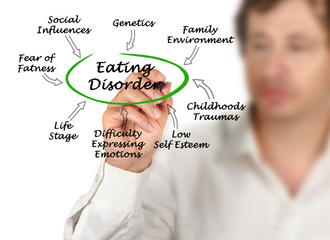Written by: Angela Kaloudis, LMHC, NCC
Clinical Training Specialist, The Renfrew Center
“The need for connection and community and the desire to be a part of meaningful and responsive relationships is at the heart of human experience.”
– Judith V. Jordan, PhD
Humans need connection in the same way we need air, food and water. In fact, we’re wired for connection and for relationships, so it is no surprise that one of the top ten most important theories in the field of human development is Relational-Cultural Theory (RCT). The reduction in stress that comes from taking part in a healthy relationship and experiencing a sense of belonging is more powerful than what can be achieved by simply breathing deeply or meditating.
We have interpersonal neurobiology to thank for this and participating in growth-fostering relationships connects our brain and our heart. This is true for all relationships, not just romantic and not just within our friendships. Any relational dynamic has the potential to become a growth-fostering connection. Yes, even the one where there are power dynamics at play (student/teacher; therapist/client; parent/child).
What is Relational-Cultural Theory?
In the Relational-Cultural Model, connection is both an encounter and an active process with respect at its core. There is this connotation of bidirectionality, and mutuality needs to be emphasized for relationships to be responsive and fulfilling.
True progress in healing and growth lies in the power of our relationships with one another and our environment. The theory examines growth within every relationship. Healing from eating disorders and isolation requires authentic connection to oneself and to others.
Why is Relational-Cultural Theory Important?
The Relational-Cultural Model is not just being nice and accepting; being in a relationship with someone is much more meaningful than that. It requires intentionality and includes the essential characteristics that are needed to foster growth: mutuality, engagement, mutual empowerment, authenticity, and an openness about differences/diversity.
RCT is dynamic, and its framework helps us grow relationally with someone. This means we examine how we feel and openly share when we’ve been impacted or moved in the relationship. When we shift in this way, we willingly and authentically lean into the connection we feel (as opposed to leaning away). RCT also helps us re-examine how we conceptualize disconnection, which inevitably happens in our most precious relationships.
How Do We Move Towards Connection?
From a relational perspective, isolation is seen as the cause of psychological distress and human suffering. Often, people leave relationships when there is a rupture, or disconnection, in the relationship.
In knowing this, our greatest recourse is to move towards connecting and not isolating; to lean into the inevitable discomfort of talking about difference, diversity and emotions with each other, to clarify our opinion, to re-connect authentically, to feel seen and heard even when we hold opposing views. How do we know when we are moving towards a growth fostering, mutual relationship? RCT tells us that we will experience a set of felt conditions known as ‘The Five Good Things’:
- Increased Energy: Each person feels a greater sense of “zest” (vitality, energy).
- Participation: Each person feels more willing and able to act.
- Clarity: Each person has a more accurate picture of the other person(s).
- Worthiness: Each person feels a greater sense of worth.
- More Connection: Each person feels more connected to themselves, the other person(s) and feels enhanced motivation to connect with others.
In these relationships, we have a willingness to take risks such as revealing our previously hidden and shameful parts. RCT also informs us that, to grow, we must approach the ruptures in our relationships. In disconnection, we feel the opposite of ‘The Five Good Things’ and this often results in people leaving relationships. What if I told you that disconnections can be healthy, rather than something to try to avoid? Further, our relationships often strengthen when we choose to actively work through these ruptures.
Relational Dynamics can be complicated, and this is often a reason why many keep their relationships at arm’s length, have relationships that have plateaued or avoid conflict because it seems easier than resolving it. Sometimes, the fear of disconnection is enough to keep us from participating authentically in relationships, hiding the parts of our personality that we believe don’t measure up or will be negatively judged. Through a RCT lens, this is called the relational paradox, where individuals mold themselves to fit in with the expectations and wishes of the other person; and in the process, the relationship itself loses authenticity and mutuality, becoming another source of disconnection.
Why Are Relational Images Beneficial?
The relational paradox is a way people have learned to participate in the relationships in the only way they know how: to keep parts of themselves hidden to feel more accepted, included and loved. The irony of this is that we feel inauthentic in this process. Often, these façades are protective, and we have them for good reason. The images we hold about relationships, and our previous experiences both impact the way we choose to participate in our relationships.
Relational images not only influence the expectations we develop about our relationships, but also impact our core beliefs and sense of self. Relational images can be activated in a variety of contexts, and often become the unconscious frameworks by which we determine who we are, what we can do and how worthwhile we are. Negative relational images such as, “I’m not good enough for them to like me,” “people aren’t truthful” or “what’s the point, people will leave anyway” become the source of relational unworthiness and often fuel strategies of disconnection (eating disorder behaviors, for example) and a sense of hopelessness in relationships.
This is how disconnections present themselves early and often in relationships with others, including with the people who want desperately to feel close to us. We learn ways to keep ourselves out of relationships. RCT calls these Strategies of Disconnections.
When two people come face to face in a dyad, they bring not only their individual histories but the transgenerational complexities of the culture in which their lives are formed. Discussing how this shows up in our relationships, in the actions we take (or don’t take), and in the ways we relate to each other is imperative to the movement into deeper connection.
We can move through these images that we hold based on our previous experiences as we increase our awareness of them, remain curious about our own ways of disconnecting from relationships (and why) and engage in open and honest conversations. We can take certain relational risks when we mindfully participate in our connections. We strive to be attentive to our own experience, the other person, and the relationship, and develop clarity about the movement of the relationship. When we notice disconnection, we name it to move towards each other rather than away from each other.
Disconnections happen in all relationships, and we can repair ruptures by choosing to approach rather than avoid with less helpful coping strategies. In fact, this is how we increase our worth. In other words, as we become more relationally aware, and aware of the ways we keep ourselves out of deep connection with others, we can feel more fulfilled, accepted, authentic and therefore the need for behaviors (like eating disorder behaviors) decreases.
Conclusion
Relationships are an active process, and when we feel less alone and feel accepted for who we are, they are worthwhile. When we look at power dynamics, our own histories, differences, our own relational images and participate in our relationships by being responsive, authentic, open, and mutual, we heal and grow.
We need Relational-Cultural Theory now more than ever. This will help shift the dominant paradigm from “me” to “we,” thereby creating a more just and hopeful world.



